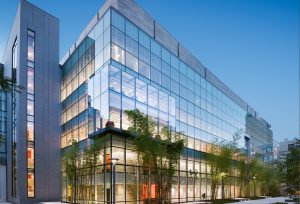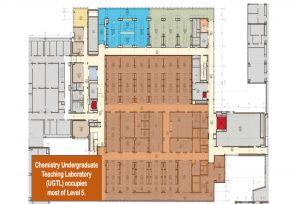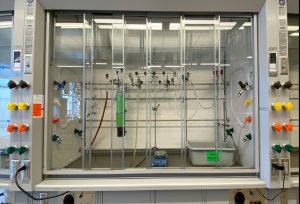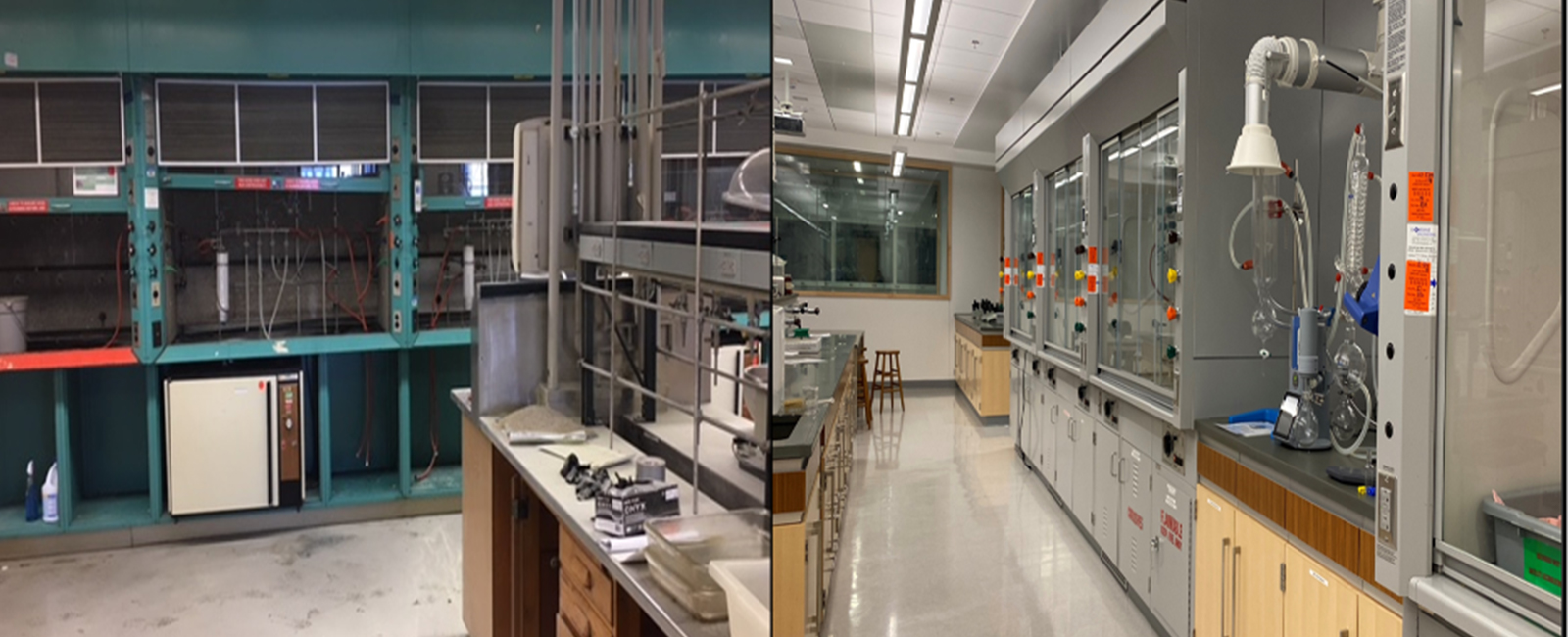The Original Lab
The original Chemistry Undergraduate Teaching Lab (UGTL) in Building 4 was built in 1916, it served generations of students, both majors and non-majors. In the photo, on the left is the original lab with stainless-steel benchtops and handcrafted cherry wood student lockers. The lab received some repairs in 1983, decades later, the need called for revitalization: the HVAC system was outdated, the lab had no air conditioning, the roof leaked, hoods were rusty, and the student demand for chemistry labs had outgrown the size of the original lab. In the photo, on the right, it shows the new Chemistry UGTL located in Building 12 on the top floor of MIT.nano.
The old lab served our students for over 100 years. It was around 18,000 sq ft with approximately 300 student lockers, a stockroom and a number of mini labs. Closing the old lab started in April 2018 and took four months. The entire contents of the century old lab were packed up, over 300 student lockers filled with glassware, and mini-labs distributed throughout the main lab, each with equipment and glassware. A team of Undergraduate students worked under close supervision to empty, sort, categorize and inventory the entire old lab contents. Learning from the experience of packing up the old lab, the new UGTL has implemented, and continues to implement, many safety checks and innovative procedures in the new lab in order to keep pace with teaching and learning adventures and instill a chemical safety mindset into students and staff. As a direct outcome of this lab move experience, the UGTL designed a TA check out form, where TAs now sign off stating that all samples have been removed at the end of every semester, attaching photo documentation and identifying locations of anything that is left behind. This is one example where the UGTL has found opportunities to improve and evolve elements of their safety program.
The New Undergraduate Teaching Lab
In March 2018, the MIT Chemistry Undergraduate Teaching Laboratory (UGTL) began preparations to move to a new teaching lab space in the top floor of the new MIT.nano building in the heart of MIT’s campus. The photo shows a view looking at the building from the Improbability Walk, named in honor of the late Professor Millie Dresselhaus.

MIT.nano is MIT’s new state-of-the art nanoscience and nanotechnology research and teaching facility. The building is approximately 214,000 gross square feet, with about 100,000 sq ft of this dedicated to lab space. It is located in the heart of campus, acting as connective tissue to the various departments across MIT. The basement is the quietest part of campus, dedicated to imaging and metrology characterization. Above this is the two-level cleanroom complex, with Class 100 and 1000 cleanrooms used for micro- and nanofabrication.

On the 5th floor is the packaging lab and the Chemistry UGTL. Below is a schematic of the fifth floor. The Chemistry UGTL occupies the majority of the 5th level, so MIT.nano and Chemistry are the only two occupants of Building 12.
Environment, Health, and Safety
MIT’s Office of Environment, Health, and Safety oversees the entire campus environmental and safety issues, the Chemistry Department and UGTL are under that umbrella. A great strength of EHS at MIT is that we have stakeholder involvement at all levels and that implementation of the EHS framework in a department is, by design, flexible to accommodate the unique needs of the various departments, labs, and centers at MIT. This model of centralized oversight and local control really emphasizes this close partnership between the EHS Office and the departments they serve.
Looking specifically at the Chemistry Department, one sees that embedded within the department is an EHS Coordinator who provides day-to-day oversight of EHS matters within the department. The EHS Coordinator works closely with PIs and supervisors (Whitney Hess, UGTL Director), as well as the designated EHS representatives for each lab (Amanda Trainor, Lab Manager). From the EHS Office, a designated lead contact (Steve Monstur, Hazardous Waste Manager) and representatives from each EHS discipline provide technical expertise. In addition, each department has an EHS Committee. The Chemistry EHS Committee is co-chaired by a senior faculty member (Professor Rick Danheiser) and the EHS Coordinator, with additional participation by faculty, graduate students, and administrative staff. The committee assists with development and implementation of the Chemical Hygiene Plan, and reviews inspection and incident/injury trends, training compliance, and other EHS matters for the department.
Around the Lab
Click here to view a gallery of photos of the UGTL.
Our Equipment
Fume Hoods
The UGTL houses a total of 69 fume hoods. Four are handicapped accessible, and they range in size from 4’ to 7’. The hoods are inspected annually. We calculated we can get up to 31 air exchanges per hour with the hood sashes open. That’s like one air exchange every 1.9 minutes. Our fume hoods ensure the lab has the cleanest air possible.
All the fume hoods have an emergency purge exhaust accessible at the push of a button. If there is a spill, we can significantly increase the exhaust flow quickly to ventilate the lab.

Each hood is equipped with nitrogen, air, vacuum and chilled water. Look closely and you will find N2 regulators have been installed on all the N2 lines. This is a safety feature to make sure the pressure is not too high going into the Schlenk lines. About half of the 69 fume hoods are equipped with Schlenk lines and Vacuum manifolds. Our chemistry majors and non-majors use these when working with air/sensitive compounds, doing vacuum distillations or pulling solvent off their reaction products. Below each hood there are two built in rheostats. This is an important safety feature incorporated into all the lab hoods.
Glove Boxes

The UGTL features a large room devoted just to its glove boxes. This is where our chemistry majors do lab modular experiments involving air/moisture sensitive and highly reactive materials. All of the glove boxes and rough pumps are vented into snorkel exhausts in the ceiling. This room is also home to two MALDI Mass Spectrometers.
Teaching
Teaching Fellow training starts with a half day orientation where they learn about their roles as TFs, waste handling, & safety issues. Once complete they are put in the lab for one week where they do all of the experiments the students do in a semester. In the evenings they take online courses such as the modular Chemical Hygiene and Safety for Chemists that teaches the procedures for working with hazardous substances. They also take a two-hour managing hazardous waste course and are assessed at the end requiring a grade of 80 to pass. All graduate students take a hands-on fire extinguisher training course.
Our new lab is used by both Chemistry majors and non-majors, educating students from many departments across MIT. Continuing the tradition of hands-on laboratory courses with a strong commitment to safety training, undergraduate students build a solid foundation on the significance of lab safety to prepare them to be safety leaders in the real world, chemical enterprise, or other professional environment. The chemistry majors and double majors do modular lab experiments written by our Chemistry faculty that are in some cases linked to ongoing research in their labs or discoveries they have made. The program is called Undergraduate Research Inspired Experimental Chemistry Alternatives (URIECA). The non-majors take Laboratory Chemistry, 5.310, this course is populated by sophomores, juniors and seniors from many different academic disciplines, in the past, about 1/3 of these students are going on to medical school. Every student enrolled in a lab-based course in the UGTL is required to attend the department safety lecture.
Green Initiatives
Some of our Green Initiatives are:
- Some of the Lab Modules / Experiments are Green Chemistry based such as Professor Timothy Jamison’s Flow Chemistry Module.
- Our streamlined waste management is another green initiative.
- Establishing an online inventory for all of our chemicals and supplies.
- Acetone recycling, we recycle about 6 gallons each semester.
- We no longer have tanks of H2 gas in the lab. We have installed H2 generators to produce the H2 we need to operate the FIDs on our GCs.
- We recently installed a Waters UPLC-MS which uses fractions of the solvents that a traditional HPLC would use translating to less waste. Lower flow rates, higher pressure.
(Another instrument not shown here is our Inductively Coupled Plasma-MS, the instrument detects elements on the part per trillion level. There are only two of these instruments at MIT. We use ours in the non-major lab, students analyze for 29 different elements in the Charles River)
- All 69 hoods have now been set up for hood hibernation shutting off after the lab closes each day. The energy savings is significant.
- We replaced all the oil pumps on our rotary evaporators installing Vacuubrand Dry pumps that are totally quiet, free from any odor, and with the push of a button literally do the distillation for you.
Accolades
The MIT Undergraduate Chemistry Teaching Laboratory received the 2020 ACS Safety Stratus Award. The award recognized the most comprehensive Laboratory safety program in undergraduate higher education. We all work in a lab that’s been top ranked in the U.S. in terms of safety.
The content of this page was compiled by Dr. John Dolhun, PhD ’73, and Dr. Whitney Hess, PhD ’17, based on their American Chemical Society Safety Stratus Presentation.

